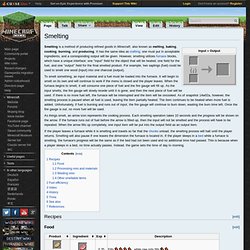

Furnace. Smelting is a method of producing refined goods in Minecraft, also known as melting, baking, cooking, burning, and producing.

It has the same idea as crafting; one must put in acceptable ingredients, and a corresponding output will be given. However, smelting utilizes furnace blocks, which have a unique interface: one "input" field for the object that will be heated, one field for the fuel, and one "output" field for the final smelted product. For example, two saplings (fuel) could be used to smelt one wood (input) into one charcoal (output). To smelt something, an input material and a fuel must be loaded into the furnace. It will begin to smelt on its own and will continue to work if the menu is closed and the player leaves. As things smelt, an arrow icon represents the cooking process.
If the player leaves a furnace while it is smelting and travels so far that the chunks unload, the smelting process will halt until the player returns. [edit] Recipes [edit] Food [edit] Wasting ores. Crafting. Crafting is the method by which many blocks, tools, and materials are made in Minecraft. In order to craft something, players must move items from their inventory to a crafting grid. A 2×2 crafting grid can be accessed from the player's inventory. A 3×3 grid can be accessed by using a crafting table. Java & Bedrock Edition crafting system[edit | edit source] For some items, the arrangement of their ingredients on the crafting grid is unimportant.
On the other hand, many of the more important or useful game objects must have their ingredients placed in the correct relative positions on the crafting grid. Players always have access to the 2×2 crafting grid from their inventory screen, and this can be used whenever the screen is brought up. Notes Jump up ↑ On this wiki, shapeless recipes are marked with a pair of intertwined arrows on the crafting table graphic. Recipe Book[edit | edit source] Crafting recipes are organized in several different categories, as follows: Pressing or. Data values. These data values refer to the different types of blocks and items. They are used in many, many places in Minecraft. Block IDs are used to define blocks placed in the world and inventory items (including items in chests and items dropped in the world). Item IDs are only valid for items. There are also Entity IDs for entities such as mobs and projectiles.
Block data further defines blocks placed, describing for example the height of water or the direction a torch points. IDs[edit | edit source] Key Horse Variants[edit | edit source] Horse entities have variant fields that determine the markings on the horse. Variant names taken from the names of the texture file they correspond to. Summoning a horse entity without specifying the Variant value will result in a white horse.
Using a Variant value that is not a true ID (all true IDs are displayed on the chart above) will result in an invisible horse. Biome IDs[edit | edit source] Enchantment IDs[edit | edit source] Status effects[edit | edit source]